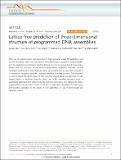Lattice-free prediction of three-dimensional structure of programmed DNA assemblies
Author(s)
Pan, Keyao; Kim, Do-Nyun; Zhang, Fei; Yan, Hao; Bathe, Mark; Adendorff, Matthew Ralph; ... Show more Show less
DownloadBathe_Lattice-free prediction.pdf (1.667Mb)
PUBLISHER_CC
Publisher with Creative Commons License
Creative Commons Attribution
Terms of use
Metadata
Show full item recordAbstract
DNA can be programmed to self-assemble into high molecular weight 3D assemblies with precise nanometer-scale structural features. Although numerous sequence design strategies exist to realize these assemblies in solution, there is currently no computational framework to predict their 3D structures on the basis of programmed underlying multi-way junction topologies constrained by DNA duplexes. Here, we introduce such an approach and apply it to assemblies designed using the canonical immobile four-way junction. The procedure is used to predict the 3D structure of high molecular weight planar and spherical ring-like origami objects, a tile-based sheet-like ribbon, and a 3D crystalline tensegrity motif, in quantitative agreement with experiments. Our framework provides a new approach to predict programmed nucleic acid 3D structure on the basis of prescribed secondary structure motifs, with possible application to the design of such assemblies for use in biomolecular and materials science.
Date issued
2014-12Department
Massachusetts Institute of Technology. Department of Biological EngineeringJournal
Nature Communications
Publisher
Nature Publishing Group
Citation
Pan, Keyao et al. “Lattice-Free Prediction of Three-Dimensional Structure of Programmed DNA Assemblies.” Nature Communications 5 (2014): 5578.
Version: Final published version
ISSN
2041-1723